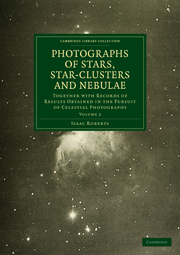 Photographs of Stars, Star-Clusters and Nebulae
Photographs of Stars, Star-Clusters and Nebulae Book contents
- Frontmatter
- PREFACE
- Contents
- LIST OF THE PLATES
- INSTRUMENTS
- LIST OF ABBREVIATIONS ADOPTED IN THIS WORK
- The Negatives–measurement of the photographic field–scales of the enlargements
- Epoch of the Fiducial Stars, A.D. 1900
- Table
- Deterioration of the Negatives
- Effects of Atmospheric Grlare and of Diffraction upon the films of photographic plates
- Arrangement of the Plates
- Method for micro-puncturing the photographic discs of stars on plates to obtain their optical centres for purposes of measurement
- Star Catalogues and Photographic Charts
- Duration of the effective exposures given to photographic plates in the 20-inch reflector
- Are the millions of Stars and the numerous Nebulosities, which are now known to exist, limited in number and extent; and do they consequently indicate that the Universe, of which the Solar System constitutes a part, is only one member of a greater Stellar Universe?
- The Evolution of Stellar Systems
- Inferences suggested by examination of the Photographs
- Description of the Photographs
- Description of the Photographs
The Evolution of Stellar Systems
Published online by Cambridge University Press: 05 July 2011
- Frontmatter
- PREFACE
- Contents
- LIST OF THE PLATES
- INSTRUMENTS
- LIST OF ABBREVIATIONS ADOPTED IN THIS WORK
- The Negatives–measurement of the photographic field–scales of the enlargements
- Epoch of the Fiducial Stars, A.D. 1900
- Table
- Deterioration of the Negatives
- Effects of Atmospheric Grlare and of Diffraction upon the films of photographic plates
- Arrangement of the Plates
- Method for micro-puncturing the photographic discs of stars on plates to obtain their optical centres for purposes of measurement
- Star Catalogues and Photographic Charts
- Duration of the effective exposures given to photographic plates in the 20-inch reflector
- Are the millions of Stars and the numerous Nebulosities, which are now known to exist, limited in number and extent; and do they consequently indicate that the Universe, of which the Solar System constitutes a part, is only one member of a greater Stellar Universe?
- The Evolution of Stellar Systems
- Inferences suggested by examination of the Photographs
- Description of the Photographs
- Description of the Photographs
Summary
A century has elapsed since Laplace suggested that the sun, and planets, might have been evolved out of nebulous matter, but his imagination did not lead him to realize the much larger idea that stellar systems might also have been evolved from matter similar in its constitution.
I now propose to submit a series of photographic copies of my original negatives from which we may obtain strong evidence, if not complete demonstration, of the evolution of stellar systems.
The first part of the series will consist of photographs of rich fields of stars, and of clusters showing various degrees of concentration; these will be followed by a series of the spiral nebulæ some of them symmetrical in form, and others less symmetrical though clearly spiral. Following these again will be a number of nebulæ of circular, annular, and irregular forms, and, lastly, nebulæ consisting of large areas of cloud-like matter having irregular structural characteristics.
The appearances to which I now wish to draw special attention in the examination of these photographs are the numerous curves and lines of stars that are associated together in separate groups. The stars are of nearly equal magnitude; of approximately equal distances apart in each group, and the groups are independent of each other and of the surrounding stars.
- Type
- Chapter
- Information
- Photographs of Stars, Star-Clusters and NebulaeTogether with Records of Results Obtained in the Pursuit of Celestial Photography, pp. 22Publisher: Cambridge University PressPrint publication year: 2010First published in: 1899
